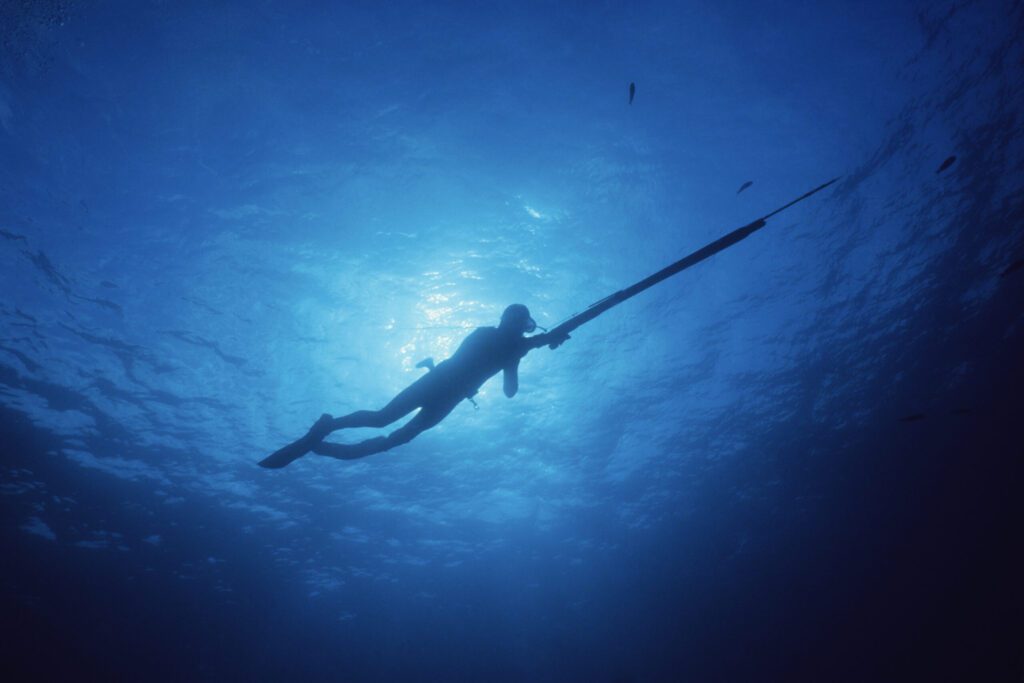Florida Spearfishing Adds Element of Adventure to Favorite Pastime
by MATT COBBLE
In Florida, nearly surrounded by open water, finding a recreational activity to do in the water is not hard. So with all of the various possibilities, why should a sportsman (or sportswoman) consider spearfishing?
In a lot of ways, spearfishing is one of the oldest methods of harvesting fish, dating to before written records existed. However, as more efficient or less intensive methods were invented (cast net fishing, rod fishing), spearfishing fell out of favor. At least, until sport fishermen rediscovered the practice in the 1930s.
For most spearfishing enthusiasts (or “spearos,” as they refer to themselves), the appeal of spearfishing is the combination of “exhilarating peace” of freediving with the thrill of hunting. Yes, spearfishing has more in common with hunting terrestrial game than fishing with a rod and reel.
Unlike fishing with a rod and reel, spearos are able to pinpoint exactly which fish they want to target. From a conservation standpoint, spearfishing is less impactful on the environment and on controlled populations.
“There’s very little bycatch,” says T.J. Konitzer, owner of Off the Wall Adventures & Outfitters in Lakeland and Brandon, as well as an avid recreational and commercial spearfisher. “Bycatch” refers to other marine life caught when fishing, either the wrong species, or undersized specimens of the same species.
Konitzer has been spearfishing recreationally for 21 years, and for the last 10 years has also spearfished commercially, offering spearfishing charters through Off the Wall Adventures. He typically takes charters to the Florida Middle Grounds, a reef in the Gulf of Mexico approximately one hundred miles west of St. Petersburg.
“We take them out and show them both the recreational and commercial aspects of spearfishing,” Konitzer explains.
“A lot of places only want to take out very experienced divers, but I don’t mind taking someone who’s learning. You have to learn somewhere, and we have good instructors.”
Konitzer has spearfished the Caribbean, Hawaii, and others, and prefers the Gulf over the Atlantic.
“There’s more fishable area in the Gulf,” he says.
Off the Atlantic coast, the depth of the ocean plummets just a few miles from the coast. In the Gulf, however, depths are between 100-150 feet for over 100 miles off the coast, including the Florida Middle Grounds.
That isn’t to say that spearfishing can’t be done closer to home. “I’ve caught hogfish and grouper under the Skyway bridge,” Konitzer adds.
But some of his greatest spearfishing trips have been about who was with him. “I took a purple heart veteran, a Marine, out to the Middle Grounds to spearfish.” He says, “it was an honor to take him out, to help him cross something off his bucket list.”
There are three levels of spearfishing equipment, depending on the spearo’s preferences, budget, and hunting style.
The pole spear is the most basic tool. As the name implies, it is a pole, usually between 4 and 10 feet long, with a sharpened tip at one end, and a rubber or elastic loop on the other. To shoot the spear, the loop is stretched to build tension, and the spear is released.
A similar device is the Hawaiian sling. This is more akin to an underwater bow and arrow or slingshot, in that the rubber loops are separate from the spear, and the Hawaiian sling remains in the hand after firing.
If the Hawaiian sling is the underwater equivalent to a bow, the speargun would be a crossbow. Rather than requiring the spearo to maintain tension on the pole spear or Hawaiian sling, the speargun only requires tension to load, and maintains the tension until fired. Spearguns come in two varieties, band powered, or pneumatic. While more costly, the speargun may be the best choice for novices as they learn the sport.
It’s important to note that certain species—such as billfish, tarpon, and all sharks—are prohibited from being harvested by spear.
Spearfishing in freshwater is completely prohibited. In addition, some areas of the state (such as Monroe and Volusia county) have much more rigorous restrictions on where spearos and spearfish, and which species may be harvested.
In order to spearfish, you must possess a Florida Saltwater Fishing License.
Whether spearfishing or rod and reel fishing, your take must comply with the established limits for numbers and sizes. One exception, however, is the invasive lionfish species. These are generally thought to be easier for spearfishers to take, and typically, no limitations are imposed.
Spearos should be careful with lionfish, however. Their spines are venomous, and a sting can be quite painful. Konitzer describes it as “on a scale of one to 10, a 20. After about the third hour it was down to a 10.”
There is one thing Konitzer says prospective spearfishers should not be concerned with. “Sharks aren’t as bad as everyone thinks it is – it’s played up. They’re interested in the fish, not you.”

